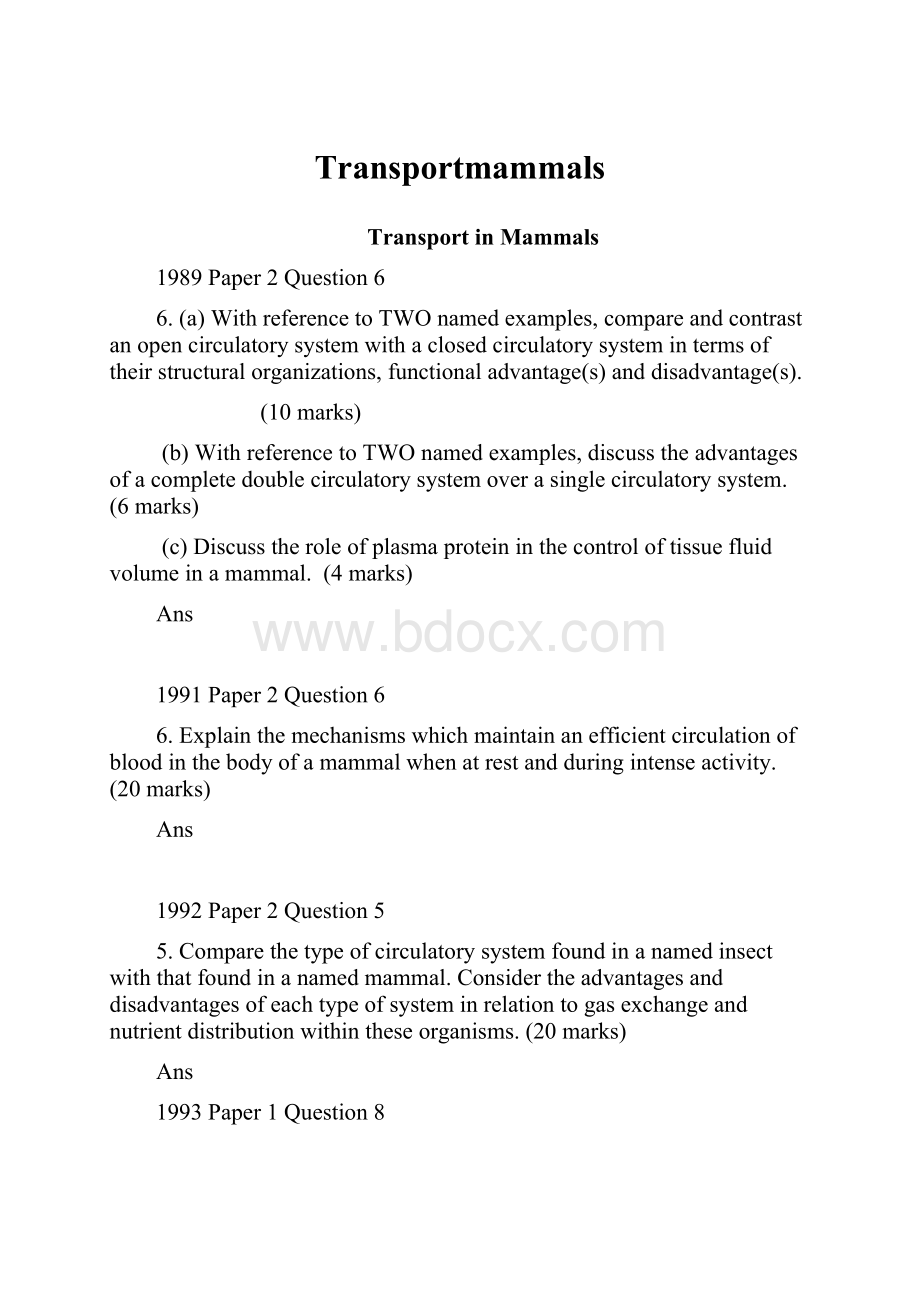Transportmammals.docx
《Transportmammals.docx》由会员分享,可在线阅读,更多相关《Transportmammals.docx(22页珍藏版)》请在冰豆网上搜索。

Transportmammals
TransportinMammals
1989Paper2Question6
6.(a)WithreferencetoTWOnamedexamples,compareandcontrastanopencirculatorysystemwithaclosedcirculatorysystemintermsoftheirstructuralorganizations,functionaladvantage(s)anddisadvantage(s).
(10marks)
(b)WithreferencetoTWOnamedexamples,discusstheadvantagesofacompletedoublecirculatorysystemoverasinglecirculatorysystem.(6marks)
(c)Discusstheroleofplasmaproteininthecontroloftissuefluidvolumeinamammal.(4marks)
Ans
1991Paper2Question6
6.Explainthemechanismswhichmaintainanefficientcirculationofbloodinthebodyofamammalwhenatrestandduringintenseactivity.(20marks)
Ans
1992Paper2Question5
5.Comparethetypeofcirculatorysystemfoundinanamedinsectwiththatfoundinanamedmammal.Considertheadvantagesanddisadvantagesofeachtypeofsysteminrelationtogasexchangeandnutrientdistributionwithintheseorganisms.(20marks)
Ans
1993Paper1Question8
8.(a)Inanexperimentperformedonadog,therelationshipbetweencardiacoutputandbloodvolumeoftheleftventriclejustbeforecontractionstartedwasstudied.Thisrelationshipwasstudiedbyartificiallychangingthetotalbloodvolumeoftheanimal,thusalteringtheventricularvolume.TheexperimentwasthenrepeatedwithsimultaneouselectricalstimulationofnerveAwhichinnervatestheheart.Theresultsareshowninthegraphbelow:
(i)Whatconclusionscanbedrawnfromthisexperiment?
(2marks)
(ii)
(1)SuggestaphysiologicalstateoftheanimalthatwouldgiveacardiacresponsesimilartothatproducedbystimulationofnerveA.(1mark)
(2)Whatisthefunctionalsignificanceofsucharesponse?
(1mark)
(iii)InjectionofchemicalXintothecirculationoftheanimalwouldgivearesponsesimilartothatproducedbyelectricalstimulationofnerveA.
(1)SuggestwhatchemicalXis.(1mark)
(2)WhatisthepossiblefunctionalrelationshipbetweenstimulationofnerveAandchemicalXonthefunctioningoftheheart(2marks)
(b)Inanotherexperiment,theheartrateofthedogundereachofthefollowingconditionswasmonitored:
(1)intherestingstate(asthecontrol),
(2)electricalstimulationofnerveAwhichinnervatestheheart,and
(3)electricalstimulationofnerveBwhichalsoinnervatestheheart.
Theresultsareasfollows:
Restingstate
NerveAstimulation
NerveBstimulation
Heartrate(beats/min)
130
180
100
(i)Statetheeffectsoftheabovenervestimulationsonheartrate.Whatcanyoudeduceaboutthenatureofinnervationstotheheart?
(2marks)
(ii)Outlinethemechanismwhichaffectstheheartrateundereachofthefollowingconditions:
(1)intherestingstate
(2)whennerveAisstimulated
(3)whennerveBisstimulated(4marks)
(iii)WhichpartofthenervoussystemisresponsibleforregulatingtheactivitiesofnervesAandB?
(1mark)
(c)Basedontheresultsofalltheaboveexperiments,summariseyourunderstandingonthemechanismcontrollingcardiacfunction.(3marks)
(d)Howwouldtheheartrateofthedogattherestingstatecomparewiththatofman?
Accountforsuchadifference.(3marks)
Ans
1993Paper2Question2
2.(a)Distinguishbetweendiffusionandactivetransport.(4marks)
(b)Statefourenvironmentalfactorsthatinfluencesaltabsorptioninplants.Explainhoweachexertsitseffect.(6rnarks)
(c)(i)Givethreeexamplesofbodyfunctionsinmammalswhereactivetransportisessential.
(ii)Brieflydescribethefunctionalsignificanceofactivetransportineachcase.
(iii)Withreferencetooneofthefunctionsyouhavementionedin(i),describehowthestructure(s)concernedis/arestructurallyadaptedtothisfunction.(10marks)
Ans
1993Paper2Question7
7.Giveanaccountoftheroleofbloodintheuptake,transportandreleaseofrespiratorygases.(20marks)
Ans
1995Paper2Question1
1.(a)Describeandexplainhowlymphisformedfromblood.(7marks)
(b)Explaintheimportanceofthelymphaticsysteminmammals.(7marks)
(c)Compareandcontrastgaseousexchangeinahumanadultandfoetus.(6marks)
Ans
1996Paper1Question12
12.Thefollowingfigurepresentsthechangeofpressurewithtimeintheleftatrium,leftventricleandaortaduringtwocardiaccyclesofahealthyyoungmanatrest.
(a)DuringtimeperiodJ,theleftatriumisatdiastole.Describeandaccountforthechangesinatrialpressureduringthisphaseofthecardiaccycle.Nametheheartvalveinvolvedanddescribeitsactivity.(Hint:
Thepressurechangeisrelatedtothebloodflowintheheart.)(4marks)
(b)StatetheactivityoftheleftatriumduringtimeperiodK.Howisthisactivityrelatedtothepressurechangeoftheleftventricleduringthesametimeperiod?
(1marks)
(c)(i)StatetheactivitiesoftheleftventricleduringtimeperiodsMandN.
(ii)Howwouldyouexpectthepressurechangeintherightventricletodifferinmagnitudeascomparedtotheleftventricleduringthesametimeperiods?
Explainyouranswer.(2marks)
(d)DescribethechangesinaorticpressureduringtimeperiodL.Howisthischangerelatedtotheactivitiesoftheleftventricleandbloodflow?
Nametheheartvalveinvolvedanddescribeitsactivity.(4marks)
(e)Howwouldthepeakpressureandfrequencyofthecardiaccyclesshowninthefigurechangeafterthemanhasrunupaflightofstairs?
(1mark)
Total:
13marks
Ans
1997Paper2Question6
6.Describethemechanismsthatbringaboutthemovementofwaterinthetransportsystemsoffloweringplantsandmammals.Statetwoessentialdifferencesregardingthenatureofcontrolwhichaffectswatermovementinfloweringplantsandmammals.(20marks)
Ans
Solution
1989Paper2Question6Solution
6.(a)
Opencirculatorysystem
Closedcirculatorysystem
Examples:
Mostarthropods(insects,crabs)&mostmolluscs(snails,clams)
Allvertebrates&annelids
1
Structuralsimilarities:
Thepresenceoforgan(s)(i.e.heartormodifiedbloodvessel)forthepumpingofblood,andasystemofone-wayvalvestokeepthebloodflowinonedirection
2
Structuraldifferences:
Bloodisnotenclosedwithinasystemofvessels.Afterleavingtheheartandmajorbloodvessels,itflowsintothespace(sinusesorhaemocoel)betweentheinternalorgansandtissues
Bloodisenclosedwithinasystemofbloodvesselsanddoesnotcomeindirectcontractwithothertissues
2
Disadvantages:
Advantages:
Alowpressuresystem.Bloodflowinlow.
Ahighpressuresystem.Bloodflowisfasterandhencethetransportingfunctionismademoreefficient.
2
Distributionofbloodispoorlycontrolled.
Distributionofblood(orcardiacoutput)tovarioustissuescanberegulatedbymeansofmuscle-drivenchangesinvesseldiameter.
2
Advantage:
Disadvantage:
Itdoesnotrequirethedevelopmentofapowerfulpumpingorganforpropulsionofblood.
Itismoredemandingonthehearttogeneratetheforcerequiredtopropelbloodthroughthesystemofvessels.
1
(10)
(b)ExampleB:
fish-singlecirculatorysystem1
Birdsandmammals-doublecirculatorysystemincompletedoublecirculatorysystem,bloodafteroxygenationisreturnedtotheheartandpumpedouttoothertissuesunderhighpressure.1
Thehigherbloodpressureincreasesflowrateandhenceallowsthetransportingfunctiontobecarriedoutmoreefficiently.1
Thefiltrationandremovalofwastebytheglomeruliofthekidneybecomemoreefficient.1
Theseenabletheorganismconcernedtohaveahighermetabolicrate1
Theheartissuppliedwithoxygenatedbloodinsteadofdeoxygenatedbloodinreturn,itcanpumpmoreforcefullytogeneratehigherbloodpressureandflowrate.1
(6)
(c)Plasmaproteinsaremacromoleculesandmostofthemaretoolargetopassthroughthewallofcapillaries1
Asaresulttheygiverisetoacolloidalosmoticpressurewhichishigherforplasmathanfortissuefluid.1
Thegradientofcolloidalosmoticpressureatthevenousendfavorsnetreabsorptionoftissuefluidfrominterstitialspaceintocapillaries.
Itisimportantincounteractingthehydrostaticpressuregradientatarterioleendwhichbringsabouttissuefluidformationbydrivingfluidoutfromcapillariesintotheinterstitialspace.2
(4)
1991Paper2Question6Solution
6.Restingcondition/normalactivities:
(10)
-heart:
-myocardialrhythm
-pacemaker:
actionofSAnode,AVnodeandPurkinjefibers
-characteristicsofcardiacmuscle:
notfatigued
-contractionofheartcreatedapressure(systolicpressure=120mmHg)forcingbloodintothearteries
-distendingtheelasticwallofthearterieswhichrecoilandpushbloodforward(diastolicpressure=80mmHg)
-semilunarvalvespreventbackflowofbloodintotheheart
-venousbloodflowmaintainedby:
a.residualheartpressure
b.contractionofadjacentskeletalmuscles
c.valvespreventingbackflow
d.inspiratorymovementofthechest
e.hydrostaticpressureoftissuefluid
Controlofcirculationtoadjusttodifferentphysicalstatesofactivity:
(10)
Controlofheartbeat(cardiacrhythm)
-cardiovascularcenter(withinthemedullaofthebrain)accelerates/deceleratestheheartratebysendingnerveimpulsesalongthesympathetic/parasympathetic(vagus)nervetothepacemaker
-whichnervebeingstimulateddependsonfactorslike:
pH,CO2concentrationofblood(sensedbychemoreceptorsinbloodvessel),bloodpressure(sensedbybaroreceptorsinbloodvessel)wh